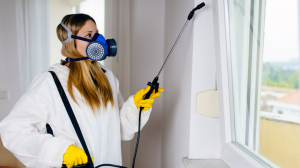Pest Control Van Nuys is the effort to keep pest populations below levels that cause unacceptable damage. Control can be by suppression or prevention.
Choose a formal structure for your business: A sole proprietorship, partnership, LLC or corporation. Obtain an EIN for tax purposes.

Monitor the condition of your fields, buildings and landscape to identify pests and their numbers. Correctly identifying the pest helps you develop and implement a management strategy.
Identifying the Pest
Identifying pests accurately is the first step to controlling them. Correct identification helps you know whether a pest can be tolerated or needs to be eliminated. It also helps you determine how to control them safely and effectively. Pest identification provides important information such as what the pest eats, what environmental and harborage conditions it prefers, how it reproduces, and other biological clues.
To determine what pest you have, look at the pest closely and take note of its size, shape, color, behavior, where it is found and any damage it has caused. For insects and rodents, observing tracks or droppings is another helpful way to identify the pest.
If possible, use a pest identification guide to help you identify the pest. Using these guides, click on the picture that most resembles your pest. Then read about the pest to learn more about its characteristics, habits, habitats, threats, signs of an infestation and prevention and control measures.
Pests can carry diseases that can harm humans, pets and plants. They can also contaminate food, water and surfaces. For these reasons, some pests may not be tolerated in certain areas such as dwellings; schools, offices and health care, food processing, and storage facilities.
A pest’s biology can be a key factor in deciding how much of a pest problem is acceptable. Some pests can be controlled by changing the environment to make it less attractive to them. For example, altering the lighting in an area to reduce the amount of available light can discourage plant disease organisms that cause crop problems.
Managing a pest problem may involve applying pesticides to eliminate the pest or using other methods such as baits, traps, or exclusion techniques. To apply a pesticide safely and effectively, you need to know which pest you have.
Pests with six legs, such as cockroaches, beetles and flies, are insects. Arachnids such as spiders and mites have eight legs. Some arachnids are predatory and some parasitic. The use of natural enemies to control a pest is called biological pest control. Typical biological controls include predation, herbivory or parasitism and are often part of an integrated pest management program.
Identifying the Source of the Problem
Pests can wreak havoc on a business, damaging property, contaminating food and reducing productivity. Identifying and understanding the problem can help prevent major infestations that can lead to costly repairs, health department violations and lost revenue.
The first step in pest control is to avoid the pests, if possible. Keeping the environment clean and clutter-free can reduce the attraction of rodents and insects, and regular sweeping, vacuuming and mopping can remove their droppings and other signs of activity.
Sealing entry points such as windows, doors, vents and cracks in walls, floors and ceiling foundations can also help. In addition, removing trash on a consistent basis and using containers with tight-fitting lids can deter pests from making their homes in the garbage.
If you are moving into a new home, be sure to inspect for evidence of pests before buying the property. Leaky pipes, dripping faucets and clogged drains can attract pests, while clutter and stacks of boxes can provide hiding places for them to breed and grow.
Once you have identified the pests and their source, a strategy for extermination or management can be developed. This may involve a combination of tactics including baits, traps and direct spraying with insecticide or other pest control substances. Insecticides should be used sparingly, and a thorough inspection of the property should be made to determine the most suitable application methods.
In some cases, it can be difficult to determine the exact pest species and its exact numbers. Correct identification can help to decide whether the pest is a nuisance or a serious threat that requires control. Monitoring also provides valuable information about the biology of the pest and its response to different environmental factors, helping to design an appropriate control program. In addition, monitoring helps to detect pest problems earlier, when they are more easily corrected. This can save money in extermination and repair costs and reduce health risks to humans and pets from repeated exposure to pesticides. Monitoring also provides valuable data about the success of a pest control strategy and can indicate when additional measures are required.
Developing a Plan of Action
Once pest identification and inspection procedures are complete, an integrated pest management (IPM) action plan should be developed. This plan will include all physical and mechanical intervention, as well as any pesticides that are to be used. It should also include the time and frequency of intervention, the locations for each intervention and what equipment will be needed to do the work. The IPM action plan should be updated periodically to reflect any changes in the environment or any other factors that may affect pest control efforts.
The IPM approach focuses on prevention, identifying and implementing practices to keep pest populations below pre-determined levels that are acceptable for economic or aesthetic reasons. This is done through the establishment of action thresholds, which are determined by monitoring pest numbers and environmental conditions. These thresholds are based on a pest’s ability to cause unacceptable damage. The idea is that if a threshold is set at an acceptable level, the pests will not cause sufficient harm to warrant controlling them.
IPM programs also focus on reducing the need to use pesticides through preventive measures, such as good sanitation, avoiding attracting pests with food sources, maintaining proper planting and cultural practices and selecting tolerant or resistant plants. Non-chemical controls are given more priority than chemical controls, which may be used only when other less risky methods do not provide the results desired. If continued monitoring, identification and action thresholds indicate that preventive measures are not effective, additional control methods are employed, such as the application of highly targeted, least toxic chemicals or the use of mechanical controls, such as trapping or weeding. Broadcast spraying of non-specific pesticides should be avoided, as it is considered a last resort.
Custodial staff should be trained on IPM and encouraged to participate in the process of preventing pests from entering a facility. They should be familiar with all IPM procedures and tools, including approved product lists and IPM tracking forms. The training should also cover preventative actions, such as proper sanitation, recording pest sightings, removing food or water sources and sealing off entry points.
Implementing the Plan
A pest control plan is only effective if it is implemented and followed consistently. This is why it is important to have a team of professionals with the appropriate qualifications to ensure your staff knows what they are doing. They can also keep you informed of any changes to regulations that affect the application of pesticides and other treatments.
Regular inspections are vital to a successful pest management program. These inspections reveal vulnerabilities and potential entry points that can be easily closed with preventative methods. This reduces the need for more drastic treatment measures. Preventative measures include performing structural maintenance and removing any food, water or shelter sources that might draw pests into the facility.
It is also important to identify the types of pests that are causing the problem so that proper treatment can be taken. Accurate identification is crucial because it determines what type of pesticides or corrective actions are necessary. It is also helpful for assessing progress and determining the effectiveness of treatments.
If monitoring, identification and action thresholds indicate that pest control is required or preventative methods are no longer effective or available, IPM programs evaluate the proper control method both for its effectiveness and its risk. Less risky pest control methods are used first, such as using pheromones to disrupt pest mating or mechanical controls like trapping and weeding. Only when these methods fail or are no longer effective is broadcast spraying of pesticides considered.
Rodents are common pests in hospitals and other health care facilities, but they should not be tolerated. They can cause fires by gnawing on electrical wires, transmit pathogens and allergens, and create unsanitary conditions. Fortunately, there are several effective and low-hazard options for controlling rodents.
Integrated pest management includes the use of biological, physical and chemical methods to control pests, including weeds, diseases, and mammals. Biological pest control uses natural enemies to reduce or eliminate unwanted organisms, such as parasites and predators. This approach is less invasive and safer than traditional pesticides.
To be EPA-compliant, you need to train and educate your employees on the correct use of pesticides. You should also keep records of your inspections, pesticide use and the results of those treatments. This way, you can prove that your staff is following the appropriate procedures and ensuring a safe workplace for everyone.
